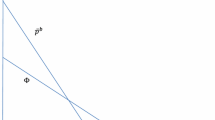Abstract
This paper amalgamates two topical issues in the economics ofcommodity taxation: the general case for non-uniformity, andthe tax treatment of commodities that are either inputs to householdproduction or close substitutes for household produced goods.Assuming a redistributive objective and that the government canimplement a non-linear income tax system and linear commoditytaxes we investigate if the existence of household productiongenerates a natural case for non-uniform commodity taxation.Four main results are reported. First, when the set of commoditiesis partitioned into consumption goods and input goods, and commoditytaxes are restricted to being within-group uniform, the compositecommodity theorem can be used to characterize the optimal commoditytaxes. Secondly, sufficient conditions for within-group uniformcommodity taxes to be fully optimal are derived. Thirdly, weargue that an input good should be taxed at a higher rate thangeneral consumption if and only if the degree of complementarityin household production (between the input good and a time-input)is larger than the degree of complementarity in consumption (betweengeneral consumption and the household produced good). Finally,we show that under simple normality, a market substitute forthe household-produced good should be taxed at a lower rate thangeneral consumption. The intuition for the last two results isthat the suggested pattern of taxation discourages ``do-it-yourself''behaviour, which relaxes the self-selection problem.
Similar content being viewed by others
References
Allen, R. G. D. (1938). Mathematical Analysis for Economists. London: Macmillan & Co. Ltd.
Atkinson, A. B. and J. Stiglitz. (1972). “The Structure of Indirect Taxation and Economic Efficiency.” Journal of Public Economics 1, 97-119.
Atkinson, A. B. and J. Stiglitz. (1976). “The Design of Tax Structure: Direct Versus Indirect Taxation.” Journal of Public Economics 6, 55-75.
Balestrino, A., A. Cigno and A. Pettini. (1999). “Direct and Indirect Taxation When Households Differ in Market and Non-market Abilities.” CES Working Paper no. 181, Munich.
Besley, T. and I. Jewitt. (1990). “Optimal Uniform Taxation and the Structure of Consumer Preferences.” In G. Myles (ed.), Measurement and Modelling in Economics. Amsterdam: North-Holland.
Boadway, R., M. Marchand and P. Pestieau. (1994). “Towards a Theory of the Direct-indirect Tax Mix.” Journal of Public Economics 55, 71-88.
Christiansen, V. (1984). “Which Commodity Taxes Should Supplement the Income Tax?” Journal of Public Economics 24, 195-220.
Cremer, H. and F. Gahvari. (1995). “Uncertainty and Optimal Taxation: In Defense of Commodity Taxes.” Journal of Public Economics 98, 291-310.
Cremer, H. and F. Gahvari. (1999). “Uncertainty, Commitment and Optimal Taxation.” Journal of Public Economic Theory 1, 51-70.
Cremer, H., P. Pestieau and J.-C. Rochet. (1998). Direct Versus Indirect Taxation: The Design of the Tax Structure Revisited. Mimeo, Universities of Toulouse and Liege.
Deaton, A. (1981). “Optimal Taxes and the Structure of Preferences.” Econometrica 49, 1245-1260.
Deaton, A. and J. Muellbauer. (1980). Economics and Consumer Behaviour. Cambridge: Cambridge University Press.
Edwards, J., M. Keen and M. Tuomala. (1994). “Income Tax, Commodity Taxes and Public Good Provision: A Brief Guide.” FinanzArchiv 51, 472-487.
Fredriksen, N. K., P. R. Hansen, H. Jacobsen and P. B. Sørensen. (1995). “Subsidising Consumer Services: Effects on Employment, Welfare and the Informal Economy.” Fiscal Studies 16, 271-293.
Heady, C. (1993). “Optimal Taxation as a Guide to Tax Policy.” Fiscal Studies 14, 15-41.
Iorwerth, A. A. and J. Whalley. (1998). Efficiency Considerations and the Exemption of Food from Sales and Value Added Taxes. Mimeo, Universities of Western Ontario and Warwick, and NBER.
Juster, F. T. and F. P. Stafford. (1991). “The Allocation of Time: Empirical Findings, Behavioral Models, and Problems of Measurement.” Journal of Economic Literature 29, 471-522.
Kleven, H., W. F. Richter and P. B. Sørensen. (1999). “Optimal Taxation with Household Production.” Forthcoming Oxford Economic Papers.
Kolm, A.-S. (1998). “Labour Taxation in a Unionised Economy with Home Production.” Working Paper 1998:7, Department of Economics, Uppsala University
Lindbeck, A. and P. Nandakumar. (1990). “Public Spending and Private Services: Macro Economic Aspects.” Oxford Economic Papers 42, 620-634.
Mirrlees, J. (1971). “An Exploration in the Theory of Optimum Income Taxation.” Review of Economic Studies 38, 175-208.
Nava, M., F. Schroyen and M. Marchand. (1996). “Optimal Fiscal and Public Expenditure Policy in a Two-class Economy.” Journal of Public Economics 61, 119-137.
Naito, H. (1999). “Re-examination of Uniform Commodity Taxes Under a Non-linear Income Tax System and its Implications for Production Efficiency.” Journal of Public Economics 71, 165-188.
Piggott, J. and J. Whalley. (1998). “VAT Base Broadening, Self Supply, and the Informal Sector.” National Bureau of Economic Research Working Paper No. 6349.
Ray, R. (1997). “Issues in the Design and Reform of Commodity Taxes: Analytical Results and Empirical Evidence.” Journal of Economic Surveys 11, 353-388.
Rosen, S. (1995). “Public Employment, Taxes and the Welfare State in Sweden.” NBER Working Paper No. 5003.
Sandmo, A. (1990). “Tax Distortions and Household Production.” Oxford Economic Papers 42, 78-90.
Sørensen, P. B. (1994). “Public Finance Solutions to the European Unemployment Problem.” Economic Policy, 223-264.
Stiglitz, J. E. (1982). “Self-selection and Pareto Efficient Taxation.” Journal of Public Economics 17, 213-240.
Rights and permissions
About this article
Cite this article
Anderberg, D., Balestrino, A. Household Production and the Design of the Tax Structure. International Tax and Public Finance 7, 563–584 (2000). https://doi.org/10.1023/A:1008749809286
Issue Date:
DOI: https://doi.org/10.1023/A:1008749809286



